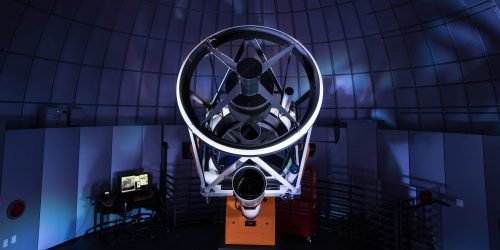
Daytona Beach, FL – Thanks to grants from NASA and the Florida Space Grant Consortium, Embry-Riddle Aeronautical University students at the Daytona Beach Campus are able to research new planets and the ages of stars.
Students Patrice Majewski and Alexander Stone-Martinez, who have been interested in space since they were young, are currently studying binary stars. Through their research, both hope to discover new planets and the ages of stars. With guidance from Dr. Terry Oswalt, Chair of the Department of Physical Sciences, and Dr. Tomomi Otani, Visiting Instructor of Physical Sciences, both Majewski and Stone-Martinez are able to see stars digitally and in real-time using the Southeastern Association for Research in Astronomy’s (SARA) telescopes in Chile, Arizona and the Canary Islands.
During their research, the students will also utilize the 1-meter Ritchey-Chretien reflecting telescope, which is the largest University research telescope in the state. The students are currently analyzing data from NASA’s Kepler Mission. The mission collected data from over 100,000 sun-like stars using a space-based telescope.
The grant from the Consortium gave Embry-Riddle 800 binary stars, or stars that orbit each other, to research and study. Embry-Riddle is the administrative institution for the Consortium, which is made up of 14 universities in total.
Preliminary findings from Majewski and Stone-Martinez and other Embry-Riddle students were presented at a recent American Astronomical Society meeting. Majewski is finalizing her research on 10 binary stars that may be eclipsing. Two of the stars seem to have a third object orbiting around them. She studies the time differences of the eclipses (one is slightly earlier and the other is slightly later) to see if there is a third object.
“That suggests something is orbiting those two stars and causing a gravitational pull that causes a delay or advance in the timing of the eclipse,” said Majewski. “If they were eclipsing each other and nothing was orbiting them, they would eclipse on a regularly scheduled time.
“There is a fair chance that one of the pairs Patrice is studying has a planet revolving around it, and if so it will be one of those rare `Tatooine-like’ planets where you could see two suns in the sky if you were on it because of how they eclipse,” said Dr. Oswalt. “We haven’t quite yet ruled out the possibility it is just a very dim star, though there is definitely something there and Patrice is working hard to identify it.”
“Through time variation of the eclipses, we are able to know not only the existence of a planet or a low mass star, but also the orbital information of it (i.e. if the orbit is circular or ellipse, the distance between the planet to the binary stars, etc.),” said Dr. Otani. “We can also use this method to search planets to many other eclipsing stars, so we want to find more `Tatooine-type’ planets with many interesting features.
Majewski spent four and a half years in the Air Force before beginning her studies at Embry-Riddle. Now a junior in Space Physics, Majewski hopes to finish her research this spring. She hopes to have a job as a research assistant or program management or pursue a master’s degree.
Stone-Martinez is an Astronomy and Astrophysics junior researching the ages of stars and the Gyrochronology method. Stone-Martinez is currently studying data from 290 binary stars. He has been able to age 20 pairs of stars that range from 250 million years old to 4.5 billion years old. His research will also be finalized in the spring.
“It’s fascinating to learn the ages of the stars. This project is hopefully a gateway to conduct more research in other areas as well,” said Stone-Martinez.
According to researchers, identifying the ages of stars is difficult. Many look to how active a star is to determine its age. Stars rotate and magnetic fields reveal spots and flares. The faster a star rotates, the more active it is and, therefore, the younger it is.
“We can determine their velocity, temperature, luminosity, mass and composition with the tools we have on the backend of our telescope, but the age is sort of a hidden quantity,” said Dr. Oswalt.
“When we know the precise ages for many stars in our galaxy, we will be able to understand more about the Milky Way’s formation history,” said Dr. Otani.
Photo courtesy of ERAU.